The Accidental Commando
I was a very unlikely prospect, but Gary Jackson knew better.
The past President of Blackwater Worldwide and ex-Navy SEAL took one look at me and saw my inner commando. It speaks highly of his perceptive powers, because at the time my legs were ready to completely give out from under me, which is how we met in the first place.
Turn back the clock to January 17, 2009. It was the third day of the sprawling four-day SHOT Show, the industry confab for everything firearms. The event was held at Orlando’s Orange County Convention Center. Some 1,800 exhibitors occupied a dizzying maze of 715,000 square feet.
We had designated the SHOT Show as the official launch of Shotgun Life. I had crisscrossed the halls dozens of times to meet with advertisers and industry luminaries.
Although I kept pushing myself, I had a devil of a time soldiering on across all 715,000 square feet of the convention hall.
Before flying down to Orlando, my doctor had insisted I undergo surgery to relieve a painful throb in my right big toe. Instead I postponed the procedure until after the SHOT Show. It was now day three, at about 4:00 PM. I was lugging tacky plastic shopping bags crammed with brochures. I felt like that big toe of mine was eating me alive. Finally, I just stopped dead in my tracks. I was exhausted, thirsty and in pain.
From my peripheral vision, I saw video images. If I was going to spend the next few minutes in one spot, at least I could be entertained. I soon realized it was a recruitment video for Blackwater Worldwide.
Unless you lived under a rock, you’ve heard of Blackwater. The company made headlines over a controversy in Iraq, congressional hearings and a Big Media smear campaign replete with invectives of mercenaries, soldiers of fortune and private army.
What I didn’t know about Blackwater, however, was that it had an entire new branding campaign ready to go.
While the weeks following the SHOT Show would bring a name change from Blackwater to Xe (pronounced zee), there stood the original Blackwater in all its glory. I looked up at the famous logo of the black bear paw. Despite my exhaustion, being that close to Blackwater was like a psychic boost of electrolytes.
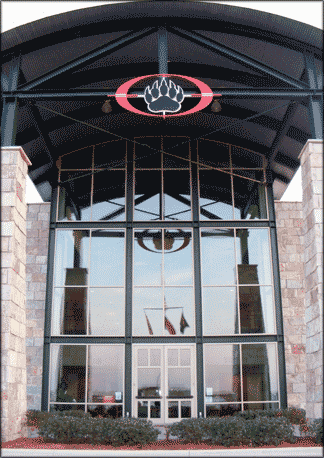
As I stood there watching the video, this gentleman approached me from the Blackwater booth. Dressed neatly in a jacket and tie, I surmised he was in his late 40s. Trim and confident, he wore eyeglasses and sported a modest moustache. When you wear a media badge at a major trade show, PR and marketing people single you out. They materialize from the crowd and try to entice you into their booths for a quick show-and-tell.
He asked me about Shotgun Life, and I explained that we covered wing and clays shooting and fine shotguns. I had glanced at his show badge, caught the name but not his title. We chatted a bit and I could tell immediately he was no ordinary PR guy. He seemed comfortable with his sense of authority, giving our conversation a genuine level of comfort that you often find with successful business leaders.
The way we were situated, I caught snippets of the recruitment video over his shoulder. Soon, Gary was inviting me to shoot at Blackwater. He explained that they offer tactical shotgun training, and it would make a great story for Shotgun Life. I reiterated that we don’t cover tactical shooting, and I simply couldn’t use the story.
Once again, Gary understood something about me that I wasn’t ready to admit: how much I would enjoy pumping out 750 rounds of bird shot, buckshot and slugs over 72 hours with my Mossberg Maverick 6-shot Model 88.
I’d bought the Mossberg about eight years ago for home defense after we had moved into an 18-room Victorian in a historic district of Baltimore (the house is gone, but the Model 88 is still with us). All black with a pistol grip and 18½-inch barrels, it was a nasty looking piece of work capable of spitting out six rounds with a vengeance. No Bulino engraving, no exhibition-grade Turkish walnut, no interchangeable chokes. It was the kind of shotgun that you used to call “freeze” instead of “pull.”

Unfortunately, I never found the opportunity to fire off all six rounds of 12-gauge devastation as in bam, bam, bam, bam, bam, bam. The Model 88 barrel was too short for our gun club and I couldn’t bring it into an indoor range.
Gary and I talked for a while, my eyes occasionally darting over his shoulders to the recruitment video. And while I knew that 750 rounds in 72 hours would make you a slacker in Argentina, it really did sound like a lot of fun if you did it commando-style. I accepted his offer.
By the end of January, I was slotted for the Blackwater course “Basic Shotgun.”
The course introduction read: “The shotgun has long been recognized as a simple yet effective solution for both personal home defense and professional tactical needs. Shotguns are inexpensive, easy to use and safe. Learn to operate and fire a shotgun properly – the Blackwater way.”
Topics covered included:
- Shotgun safety and handling
- Characteristics and accessories
- Carrying techniques
- Patterning
- Slug sight-in
- Ready positions
- Malfunctions
- Shooting positions
- Transition to shooting positions
- Multiple shoots/multiple targets
- Tactical reload
- Speed reload
- Ammunition change over
- Shooting on the move
- Shooting moving targets
- Barricades
I would be heading down to Blackwater’s main facility – 7,000 acres in Moyock, North Carolina, just south of the Virginia state line. My Basic Shotgun course was scheduled for February 25-27.
I called a few friends to share the news. I have to say, they were extremely impressed with the idea of shooting at Blackwater. That’s when I realized, saying that you were going to shoot at Blackwater was the ultimate in one-upmanship. Even after the company changed its name to Xe, in the hearts and minds of everyone I shared the experience with, they knew I shot at Blackwater – and they envied the heck out of me.
Meanwhile, a few things needed to be completed before I bombed down to Moyock in my M Coupe.
First, I had to swap out the pistol grip on the Model 88 to the full-length stock that came with the Mossberg. Shooting 750 rounds of 12-gauge shells, especially buckshot and slugs, with a pistol grip was a sure-fire way to permanently damage your wrist from the recoil.
Second, some documentation was in order as part of my course application: driver’s license, birth certificate or unexpired passport, evidence of no felony history (or you can supply a concealed-carry permit) and a letter of good character from an employer or community leader.
Since I don’t have a concealed-carry permit, I went to the local Department of Public Safety and Correctional Services for a background check. The visit took about 20 minutes. A week later the results arrived that showed a clean record.
I faxed all the documents to Blackwater and received confirmation that I was good to go.
The drive was only about five hours, but I couldn’t get there fast enough.
Even though the company had officially changed its name to Xe shortly before I arrived, the entrance sign at Moyock still read Blackwater.
Two enormous guys in jeans and camo jackets came lumbering out of the guard house, Glocks in low-slung holsters strapped to their massive thighs. They were all business, checking my credentials. Surprisingly, the parking pass they gave read U.S. Training Center, the new name of the organization that conducted my shotgun course.
The approach road to the Black Bear Inn must have been close to two miles. Helicopters continually circled. Banged-up cars with safari ramming bumpers rumbled past in the opposite direction. On my right were hangars and an airstrip. To my left were the evasive driving course and maritime training facility. I also saw my first of the ubiquitous white van transporters with Virginia license plates that were packed with uniformed and non-uniformed personnel. The road ended at the parking lot of the Black Bear Inn.
A stone façade supported double wood doors. Signs read “No Loaded Weapons Allowed in Building,” “Do Not Leave Weapons Unattended,” and “No Weapon Munitions.” Clearly, I was not checking into a Fairfield Inn.

The lobby conveyed a rustic feel, a stuffed black bear in attack stance the inn’s mascot. The women at the desk were friendly and accommodating.
The Black Bear Inn houses the luxury accommodations at Blackwater, compared with the bunk-bed barracks. As I walked down the hall to my room, I expected fluffy pillows, down comforter and Jacuzzi tub. Ha!
There was a jolt of culture shock as the room door slowly opened. The cramped space was just wide enough for a single bed in a 2 x 4 frame sans headboard. The tiny desk was accompanied by a folding chair. A small window had the curtains drawn. The coat rack on the wall hung right next to the bed. There was a TV. The bathroom was barely large enough to dry yourself after a shower. That’s when I realized they should’ve also changed the name of the lodging facilities to the Testosterone Inn.
The first morning brought frost. I scraped the windshield before driving to the chow hall, the roads lined with joggers. More of those white vans occupied the parking lot. As I pulled into a parking space, something out of Mad Max thundered toward me. It was a Ford Crown Victoria with safari ram bumper, front tires askew, headlights bashed out, grill smashed, directionals dangling by their wires and all the windows pulled. It was damn horrifying to watch this monster come straight at me. The driver cranked the steering wheel at the last minute, pulling into the next spot. Maybe they were having fun at my expense as I sat in my spotless little M Coupe. A couple of guys jumped out of the car and I followed them into the chow hall.
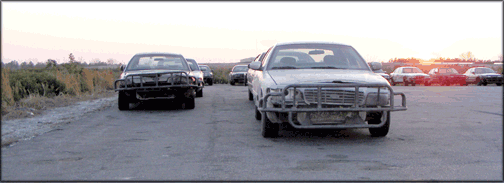
Inside, the expansive space was filled with soldiers in fatigues. To the right, long steam tables held scrambled eggs, breakfast meats, potatoes, chicken cutlets and biscuits. A separate steam table was reserved for soldiers from another country.
To the left, symmetrically lined picnic tables occupied the entire hangar-like area enclosed on two sides by floor-to-ceiling windows. A large American flag hung over the juke box blaring AC/DC’s “Dynamite.”
I got in the food line. The middle-age woman cashier called the soldiers “sweetheart” but she simply smiled at me when I gave her my voucher.
After scraping my tray clean into a garbage can, I went outside to the parking lot. Directly in front of the chow hall entrance was a combo chin-up/dip bar. Soldiers were waiting 2-3 deep to give it a whirl. Some of these guys did more chin-ups in two minutes than I’ve done in the past five years – and that was on a bellyful of breakfast.
Day one of Basic Shotguns started in a classroom. My instructor, D.H, was a former police officer who had served with Blackwater in Iraq. D.H. had a Southern drawl and a cheek-full of chaw. He wore a Blackwater Instructor t-shirt and tactical pants. He had been with Blackwater since the beginning, in 2000.
Two other students were in the class.
One of them, a guy in his early twenties, was a criminal justice intern with a job in Blackwater’s headquarters. The other was a U.S. Marine sniper. I pegged his age as late twenties. He wore a black hoodie with skull and crossbones in a Goth flourish. It turned out, that his demeanor would scarcely change from that first morning: taciturn, unsmiling, distant. One time, by instigating some small talk, he told me that he paid for the class himself to fill some idle time before returning to his fourth tour of duty in Iraq. Blackwater was about a 200-mile drive from Camp Lejeune, where he was stationed.
D.H. wrapped up his classroom introduction by saying “I’ll push you as hard as I can. If you’re not stressing yourself, you’re not learning.”
First lesson: tear down the shotgun and reassemble it. We broke for lunch afterwards and would reconvene on Range T5 at 12:30.
T5 was a 50-yard range covered with gravel. Behind us were fields of winter wheat from a neighboring farm. Berms on three sides partially muffled the sounds of gun fire coming from everywhere. At the rear of the range, a pavilion with a long table and a few chairs gave us room to work and take breaks. The front of the range held steel-plate targets. Door-size wood barricades were randomly placed along the perimeter. We would use them later.
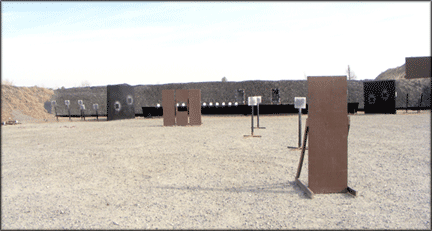
D.H. wanted to see how our shotguns patterned. He set up silhouette targets. He focused on our stance. It was in many ways similar to the standard clays position – the big difference being that you face the target square rather than keeping your feet in a neutral position common in clays. By virtue of this variation, you transform from a target shooter to a predator.
We started with #8 shot, progressing to 00 buckshot and then slugs as we moved back to the 50-yard line. The purpose of the exercise was to see how the gun performed as your ammo requirements changed. The further back from the target, the bigger the ammo, culminating with tactical slugs.
I was impressed by how the Mossberg performed, until about 25 yards out; then it drifted to the right. After using the wind sock on the range to compensate for windage, I started to nail a few good shots at 30 yards and more.
Like other weapons, safety is the first rule of tactical shotguns. But the second rule served as a cornerstone of the Basic Shotgun course: never let your shotgun run empty.
I had to constantly top off the Mossberg. Invariably, I would short-shuck the forend from fatigue. Unless you’ve experienced it first-hand, you have no idea how exhausting it can be to shuck that gun non-stop while reloading it. Your fingers, shoulders and back are put through the wringer as you mentally try to coordinate your movements and manage the recoil of shooting box after box of slugs.
If you consider yourself a sporting clays hotshot, Blackwater’s Basic Shotgun course will humble you real fast. Yes, all the basics about stance, sight picture and mount still apply, but the concentration and physical demands required for this kind of volume shooting push you to entirely new heights.
The quick-loading techniques that D.H. showed us relied heavily on the right wrist and forearm, giving me the opportunity to toughen up muscle groups gone soft from suburban sloth. Basically, you manipulate the shotgun by holding it at the pistol grip. The area between the pistol grip and the receiver is called the “workstation” because that’s what you focus on to keep the gun constantly topped off. You should always have the safety on when topping off, turning it to the red position only when you’re ready to fire.
If you’re speed loading through the ejection port, you hold the shotgun with your right hand at the pistol grip, ejection port up, muzzle angled down about 30 degrees. With your left hand you grab a shell with the primer-end against your thumb, and then use your other four fingers to sort of palm the shell into the ejection port from over the top of the receiver.
If you happen to grab the shell with the crimp against your thumb, you load it through the ejection port from under the receiver.
To load directly into the magazine, you hold the gun muzzle-down at about a 60-degree angle with the trigger guard facing up. Manipulating the shotgun by the pistol grip, you speed load the magazine with your left hand.
Since I often use a pouch for clays shooting, this speed loading required that I shift the pouch from my right side to the left.
Everybody will drop shells during these speed loading techniques. The way you pick up your shells is by kneeling, eyes forward, spotting the shells with your peripheral vision. Before you stand, look around to make sure no one behind you is shooting. You resume the shooting stance, take off the safety, then start shooting at the target. By the way, you have to perform this maneuver as fast and safe as possible.
We quickly graduated to a loading drill where we shot three, loaded three, while the shotgun is still mounted to our shoulder. For example, we would speed load while shooting at steel-plate targets 1, 3, 5 then at targets 2, 4, 6. Ideally, you wanted to top off the gun in .33 seconds.
While we did not have the pleasure of AC/DC’s “Dynamite,” there was an explosive sound track of sorts on range T5.
D.H. wore a walkie-talkie on his belt and through the speaker we kept hearing a woman’s voice shouting “ram him, ram him, keep the line, spin it.” It turned out that the evasive driving school had a female instructor who was bleeding over onto D.H.’s frequency. At the same time, gun fire was all around us as helicopters circled. My adrenaline just kept pumping.
The day flew in a shooting and loading frenzy. At around 4:30, we wrapped it up. D.H. said that so far we had been shooting from a standing position, and for tactical shotguns “standing is a luxury.” Over the next two days we would learn to shoot from what he described as “more exotic” positions.
We picked up our hulls, D.H. whitewashed the steel-plate targets and we would meet back at T5 the next morning.
That night, back in my room, as I watched mixed martial arts on Spike TV, I began to absorb the full impact of the day’s lessons. Coming from a world of wing and clays shooting, I felt truly humbled by the sheer physical exertion imposed by a tactical regimen.
It was my first inkling that my relationship with shotguns would never again be the same – as though I’d been driving a Buick all my life until one day someone handed me the keys to a Ferrari, showed me how to drive it, then cut me loose. All the boundaries are pushed further out. You comprehend the enormity of your own potential across every shotgun sport.
The next morning, the cashier still did not call me “sweetheart.” The chow hall was packed with soldiers in fatigues from another country. One of them selected a song from the juke box that had a lead singer who sounded like Celine Dion receiving a colonoscopy without the courtesy of an anesthetic. I could see some of the soldiers giving the juke box a nasty look. Finally, one of them went over to it and yanked the plug, giving rise to a round of applause.

Day two would put us on the move. We would learn how to shoot from the kneeling, prone and side positions, and then apply them to barricade situations.
We would also learn how to quickly empty the shotgun and replace the ammo with different loads. As I mentioned, the type of ammo in your gun is dictated by your distance from the target. If you’re breaching a room, you want to use 00 buckshot. If you’re firing from let’s say 15 yards, you may want to switch to slugs. Of course, not only must you change ammo on the fly, but you need to keep your shells segregated to avoid confusion. And then you have to do it all on the move.
Firing a tactical shotgun while walking forward requires that you roll on the balls of your feet, eyes forward, square to the target, hunched slightly forward.
D.H. would have us advancing while ordering us to shoot targets in a random order. He could yell “3, 5, 7” and we would have to knock down those round steel plates. He also set up square steel targets on posts that fit into ground. He would then have us shoot at the round steel targets, the square targets – any combination as we moved toward them and topped off the guns.
You also must remember that during these exercises you’re relentlessly shucking the forend, spitting out hulls. Your arms and legs are always moving – shucking, loading, shooting – advancing on the target like a tank.
Then D.H. would give the command to change ammo. You would have to unload, find the alternative ammo and speed load into the gun. Drop to your knees, retrieve the ammo, on guard for enemy and friendly fire, looking around again then stand to recommence your advance, safety off and shoot.
We performed the same drills walking backwards. Of course the difference is that you occasionally have to look behind you. Imagine this: walking in reverse, speed loading, eyes on target, change ammo on command – you get the picture. By now, your thigh and calve muscles are aching in the best possible way.
Next, we learned to shoot from a kneeling position. D.H. was considerate enough to have thick rubber mats delivered to T5, because the gravel was large and surely would have hurt our knees. When it comes to kneeling, the most important lesson is to make sure you look around before you stand up with your safety on. Again, you double check that you’re not in the line of fire.
After kneeling, we learned how to shoot from the prone position, both on our stomach and on our side. You don’t have time to first get on your knees and then down on your stomach. You kneel, support yourself with your left hand, then kick out your legs directly behind you. All the while, you must be aware of your gun position, to prevent it from scraping on the ground.
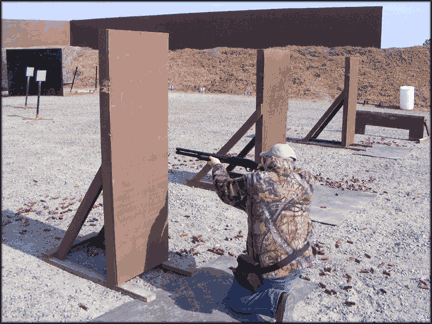
gets tactical from the kneeling position.
D.H. then brought out those barricades that had been stored on the side of the range. All the new positions were performed from behind them, or approaching them – vigilant not to protrude too far around the barricade so that we inadvertently became targets. The rule of thumb was to never let the muzzle of your gun extend beyond the barricade and you only moved your face far enough out to see the target.
When we wrapped up the second day, the Mossberg had fired about 600 rounds, getting scraped along the ground, fed ammo recovered from the dusty gravel (no time to wipe it off) in a marathon of speed loading and shooting. My biggest problem with the gun was operator error: after a while I simply got exhausted of shucking the forend, causing some ammo to hang up. Otherwise, the Model 88 ran without a hitch, which was pretty darn impressive.
As we cleaned up the field, someone had mentioned that the Southland Restaurant, about five miles away in Moyock, had great fried chicken. That was all I needed to hear.
The Southland Restaurant was a friendly neighborhood restaurant with a souvenir shop that sold cheap cigarettes. Elderly patrons circulated among the tables that included several generations. The waitress asked me whether I wanted the buffet or wished to order from the menu. Once I found out the buffet included all-you-could-eat fried chicken, the decision was easy.
It took a couple of Coronas and platefuls of crispy fried chicken before I was able to calm down and reflect on day two of the Basic Shotgun course.
While you could argue that wing and clays shooters occupy different, but overlapping cultures of the shotgun life, tactical shooting pushed the envelope to extremes.
Take, for instance, toe rests. When we shoot skeet, we rest the open shotgun on our toe. Tactical shooters would frown on that as unsafe. While wing and clays shooters baby their shotguns, tactical shooters use them as a tool in the same way that a carpenter would use a rotary saw. Even duck and goose hunters who could roll around in the muck with their shotguns can’t stand up to the sheer brutality that tactical shotguns endure.
I have a tremendous appreciation for beautiful and expensive shotguns, but working the hell out of my Mossberg over the past 48 hours revealed an aspect of shotgun ownership that verged on primal. Yes, we’ve all seen the advertisements of the grizzled hunters in severe weather aiming at their quarry with that black semi-automatic. We tend to think of that as macho. By contrast, I can say that when it comes to the shotgun life very few pursuits are as grueling as Blackwater’s Basic Shotgun course.
The thrashing that the gun endures, the sheer volume of heavy loads, the stakes at risk in the real world – are so thoroughly empowering that it completely transforms you as a shotgun owner. Your walk assumes a prouder gait, your handling of the shotgun becomes more precise, and your self-discipline as a shotgun shooter takes on a tactical edge.
While it’s great to shoot 400 x 400 at skeet, nothing rivals the self-confidence gained from shooting at Blackwater.
The morning of day three began with sharpshooting slugs on T5. We helped D.H set up a course of fire, which involved every barricade, moving target and ammo change we had been taught up to the point.
The barricades were interspersed with pole-mounted, steel-plate targets, with the knock-down plate targets further back and a square-steel plate target behind them that moved from side to side.
D.H. would brief us on the sequence of targets, positions and ammo changes. We would start by approaching a door-size barricade, shoot at a steel plate, advance to another barricade where we go prone, shoot at a few targets, move to another barricade where we made a kneeling shot – topping off the gun and changing ammo all the way through. In short, this was urban warfare training.
When we broke for lunch, my clothing and gun were coated with gravel dust. I drove to the chow hall and piled on the food. In the checkout line, the cashier called me “sweetheart.” And I have to say, she almost brought tears to my eyes.
After wolfing down lunch and several cups of coffee I met up with D.H. and my other classmates at a range that fully simulated breaching a room. Inside these “rooms” steel targets presented perpetrators and hostages. The pop-up heads on the body-shaped targets were managed by D.H. from a control panel behind us. Our mission was to go from door to window in every room and shoot the heads of the perpetrators in the shortest amount of time.
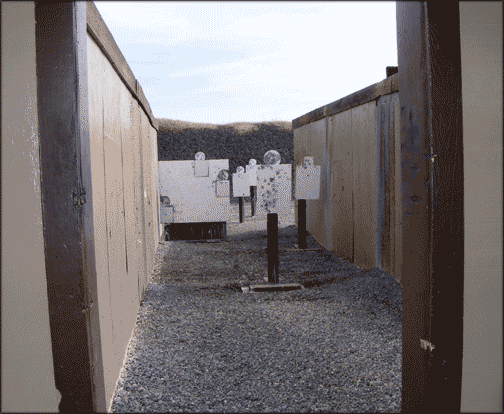
D.H. gave us a demonstration. Of the three students, I was the last one. By the time it was my turn, the “sidewalk” in front of each room was strewn with hulls.
D.H. gave me the go signal. I was rocking through the course – shooting, shucking, nailing those targets with lethal precision. Then I got to the last room, and I simply shot a door out of sequence – disqualifying my time, which otherwise would’ve beaten D.H.
What a charge!
We returned to our classroom where we completed our evaluations and I received my Basic Shotgun certificate from the U.S. Training Center. When I returned home, I hung the certificate over the long table that I use for gun cleaning. When I occasionally glance up at it though, I know in my heart that I didn’t shoot at the U.S. Training Center, I shot at Blackwater. And I have the hat to prove it.
Irwin Greenstein is Publisher of Shotgun Life. You can reach him at contact@shotgunlife.com.
Useful resources:
Then Read On…

Irwin Greenstein is Publisher of Shotgun Life. Please send your comments to letters@shotgunlife.com.

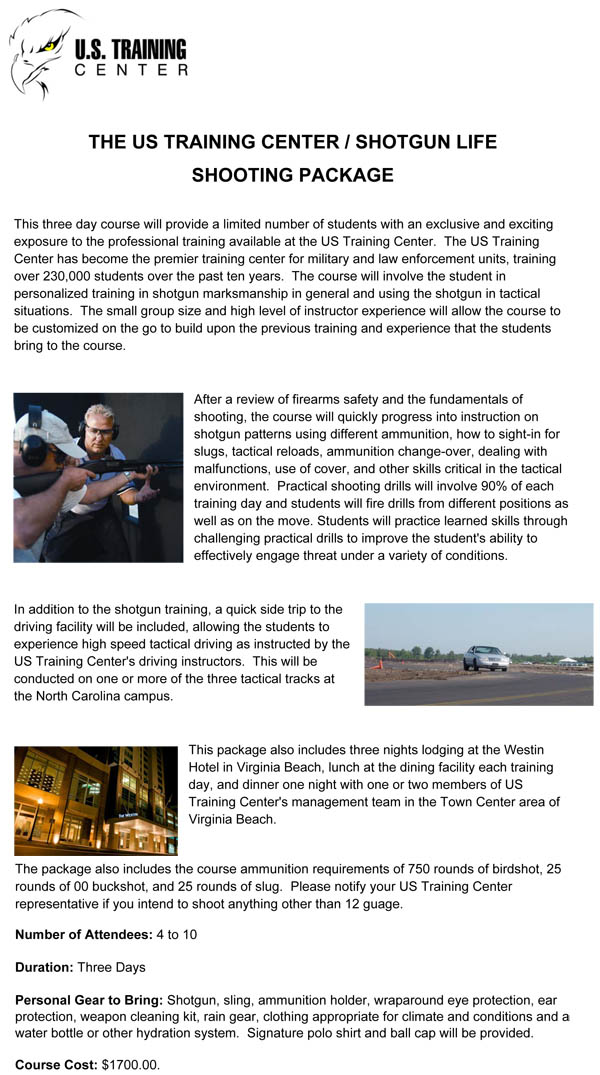
 2009 Training Application
2009 Training Application
Comments